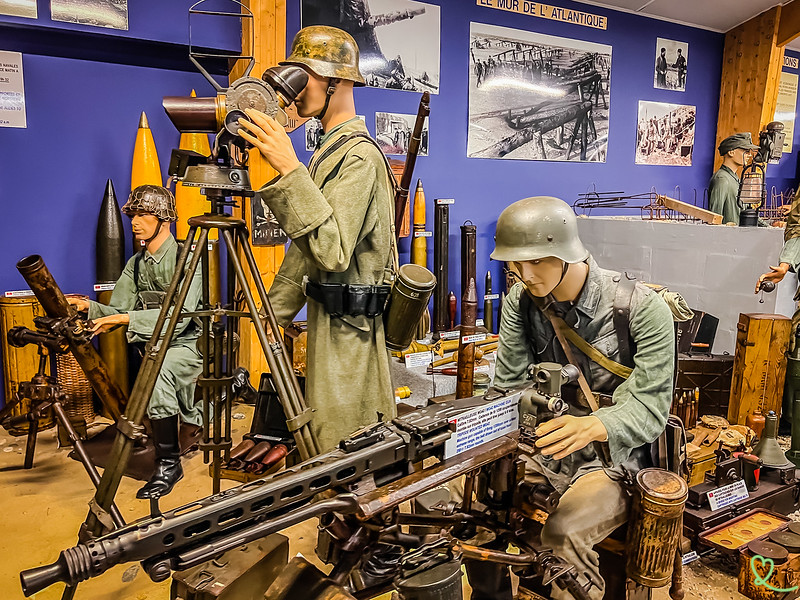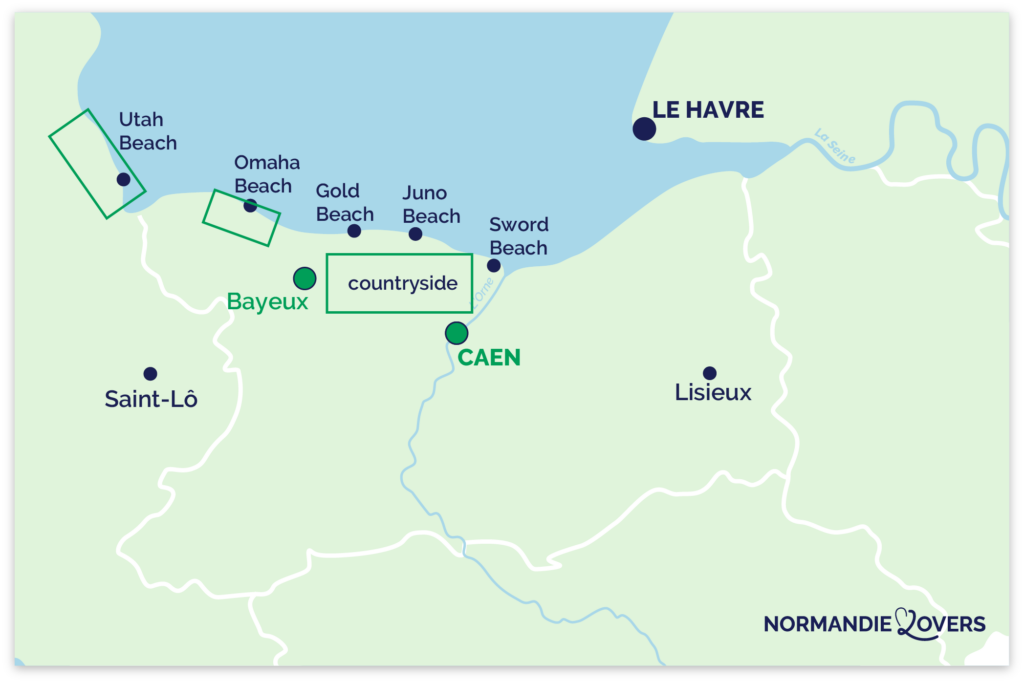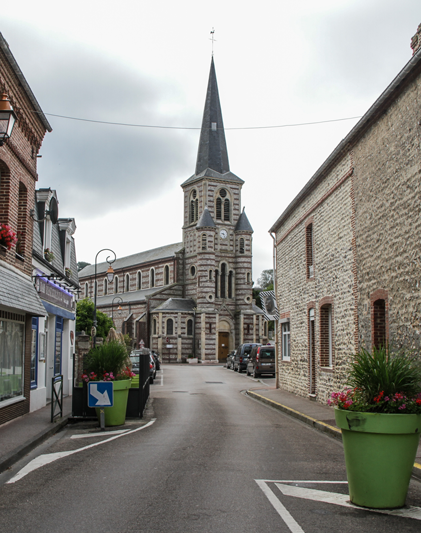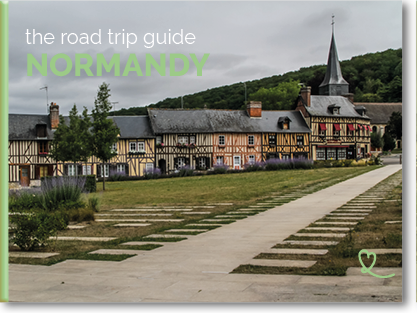The Memorial Museum ofOmaha Beach is located in Saint-Laurent-sur-Mer, just 200m from the famous Normandy landing beach. It features a collection of objects and historical documents that tell the story of the D-Day soldiers.
In this article, find our photos and all our tips to make the most of your visit to the Memorial Museum ofOmaha Beach.

This guide is completely independent, based on our experiences. We visited the region anonymously, making our own choices and paying our bills in full.
Why visit the Memorial Museum atOmaha Beach?
Is the museum worth it? Our opinion:
This museum immerses visitors in the history of the D-Day landings, with its highly successful reconstructions of scenes from daily life. We were able to appreciate the rich collection of authentic objects and documents that put this major event of the Second World War into context. The immediate proximity of Omaha Beach reinforces the emotion of the visit.
In our opinion, the museum is one of the must-see activities atOmaha Beach.

Why is the Memorial Museum atOmaha Beach famous?
The museum is famous for many reasons:
- Itsstrategic location, just 200 metres fromOmaha Beach, nicknamed “Bloody Omaha”.
- Its collection of objects, uniforms and military vehicles
- The 25-minute documentary film with poignant testimonials from American veterans
A morning guided tour of Omaha Beach and other nearby American D-Day sites is a great way to round off your exploration of the museum. See prices, photos and availability.

Our favorite moments
- Detailed reconstructions of scenes from daily life,
- Period photographs that bear witness to these historic moments,
- A collection of illustrated postcards praising the relationship between the Allied forces and the local population (especially women). They hint at the difficult situations of French women, which have been belatedly denounced.

History in brief
The history of the Memorial Museum atOmaha Beach is closely linked to the D-Day landings. Here’s what we’ve learned:
- 1996: Creation of the museum in Saint-Laurent-sur-Mer
- Strategic location 200m fromOmaha Beach
- Mission mémorielle: preserving the memory of the young soldiers who fell in 1944
- Teaching approach adapted to all audiences

STAYING NEAR THE D-Day beaches
Option 1: Bayeux
The most practical option, in our opinion, is to base ourselves in the town of Bayeux. We recommend..:
- Hotel Domaine de Bayeux in an 18th century mansion – see prices, photos and availability
- see all top rated accommodations in Bayeux

Option 2: in the countryside
In the countryside around the D-Day beaches, you will find beautiful buildings with a lot of charm: farms, manors…
- Hotel Domaine d’Utah Beach – prices, pictures and availability
- Hotel Ferme de la Rançonnière – prices, pictures and availability

Option 3: next to one of the beaches
If you’re looking for a seaside holiday or are fascinated by one of the beaches, you can choose a more specific hotel:
- Hotel Villas d’Arromanches in Gold Beach Beach – prices, pictures and availability
- Hotel La Sapinière in Omaha Beach Beach – prices, pictures and availability

Access and map: Memorial Museum ofOmaha Beach, Saint-Laurent-sur-Mer
Where is the Memorial Museum atOmaha Beach?
- In the commune of Saint-Laurent-sur-Mer
- 200m from the beachOmaha Beach
- 25min drive from Bayeux
- 40min drive from Caen
- Here’s a map of the D-Day landing beaches in Normandy to help you find your way around:

How to get there?
- Access by car is the most convenient.
- By public transport, the nearest bus stop is “Saint-Laurent-sur-Mer/Avenue de la Libération”, line 120, a 12-minute walk from the museum. Find out more here.
OUR ADVICE FOR RENTING A CAR IN Normandy
- Compare prices on our preferred platform: DiscoverCars – one of the best rated sites.
- Choose a car that is comfortable enough (distances can be long) but compact (some parking lots and villages are narrow).
- Think of thecomplete insurance (some roads are tortuous and narrow).
- There is a lot of demand, book it early.

Parking
Free parkingis available directly in front of the museum.

Useful tips: duration, schedules, eating…
Best time to visit
- We advise you to avoid the D-Day commemoration periods, which attract many visitors.
- The best time to visit is from April to September, when you can take advantage of the extended opening hours (9.30am-7pm).
- If you can, please visit us outside school vacations, for greater peace and quiet.

Length of visit and main difficulties
Allow around 1 hour for a complete tour of the museum.
The route is easily accessible and presents no particular difficulties.

Advice on how to visit
Just follow the museum’s chronological itinerary to relive the events. We appreciated this organization, which enabled us to gain a progressive understanding of the historical facts and their consequences in terms of human lives.

USE OUR GUIDE TO PLAN A
DREAM TRIP TO Normandy
All the information you need for your trip:
- 8 maps that make planning easier
- 160+ pre-selected locations
- Practical advice
- 300+ photos to help you choose

Visiting with children
We didn’t observe any specific itineraries for children, but the museum is designed to be understood by all ages.
Schedules and rates
The museum is open all year round, with opening times varying according to the season:
- February, March, October, November, December: 10:00 am to 5:30 pm
- April, May, September: 9:30 a.m. to 6:30 p.m.
- June, July, August: 9:30 a.m. to 7:00 p.m.
Adult price: €7.70

Catering
There are no food outlets in the museum, but there are restaurants near the beach atOmaha Beach. However, we have not tested them.

Subscribe to our Newsletter
- Get away from it all with Region Lovers’ beautiful destinations!
- Once a month
- Advertising-free
France under the Occupation
The daily lives of civilians under German occupation
A visit to the museum first immerses us in the difficult daily life of the French under the Occupation. We discover how the population coped with repression and restrictions. Explanatory panels detail the dramatic consequences of the exodus and the organization of the Resistance. We were moved by the fate of the French prisoners, which illustrates the harshness of the period.

German defense strategy and fortifications
German defences are presented in detail in the museum. We were impressed by the reconstruction of a bunker and by the photos of the obstacles installed on the beach, such as Czech hedgehogs, anti-tank walls and Belgian gates.

One section is devoted to the munitions and mines that dotted the beach. The presentation of the Atlantic Wall gives an idea of the scale of the defensive system put in place by the Germans.

Operation Overlord: June 6, 1944
Crossing the English Channel
The difficult conditions of the crossing are detailed in this section of the museum. We learned that the American troops had to contend with rough seas and strong winds that complicated navigation.

The re-enactments and eyewitness accounts give a real sense of the difficulties faced by the soldiers before they even reached the beach.

Logistics challenges
This part of the exhibition highlights the many obstacles encountered by the Allied forces. German defenses included a complex network of mined obstacles , barbed wire and concrete fortifications equipped with machine guns and cannons.

We were particularly struck by the information concerning amphibious tanks: almost all of them sank during the landings. You’ll also discover the importance of the Mulberry artificial harbor in the success of the operation.

Liberation and its consequences
Care for wounded and captives
The museum features a reconstruction of rescue operations using a vintage Red Cross vehicle. The picture of a convoy of captured German soldiers caught our eye, depicting the immediate aftermath of the battle. These scenes illustrate the organization of relief efforts and the treatment of prisoners in the hours following the landing.

Back to a hectic daily life
The changes in the daily lives of Allied soldiers after D-Day are also illustrated by numerous period objects and documents. We were able to see the installation of the American camps established in the region. These installations profoundly altered the Norman landscape and the lives of its inhabitants for several months.

Relations between soldiers and liberated civilians
A small collection of postcards caught our eye. It illustrates the relationship between the Allied forces and the local population, and shows French women welcoming American soldiers. These drawings were used to encourage the troops. They illustrate the complexity of the relationship between liberators and liberated, combining recognition and everyday tensions.

Frequently asked questions
Omaha Beach worth a visit?
Absolutely, it’s a must-see D-Day beach! On June 6, 1944, Bloody Omaha was the scene of fierce confrontations that resulted in very heavy casualties on both sides. This was one of the deadliest beaches on D-Day. Walk along it and you’ll see bunkers and memorials.
Discover all there is to do at Omaha Beach in our beach article.

PLAN YOUR TRIP TO Normandy
Inspiration destinations
- Deciding where to go in Normandy – the best destinations
- Our weekend ideas: best-of, romantic, unusual, seaside, luxury, family
- 16 seaside hotels in Normandy
- The most beautiful charming hotels in Normandy

Best of

Practice
- Where to stay in Normandy – best places and hotels
- See our tips for renting a car at CDG airport, Orly airport, Beauvais airport, Caen, Rouen, Bayeux…






